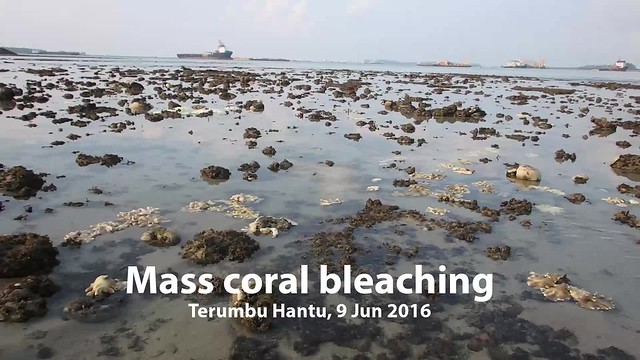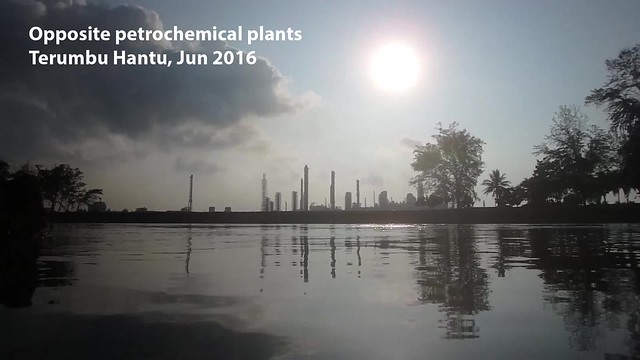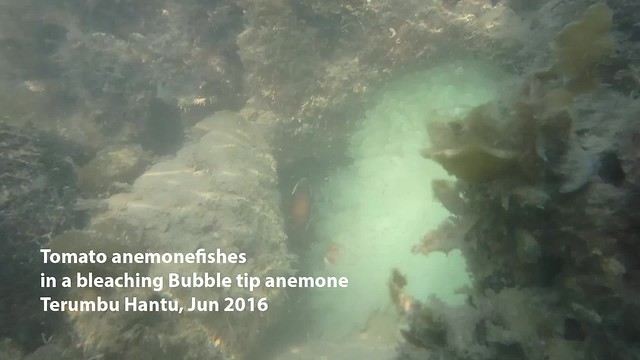About 60-70% of the hard corals and soft corals that I saw were bleaching.
This was not unexpected. From the NOAA's coral reef watch satellite monitoring shows that Singapore is in the Watch zone. Where we should be prepared for mass coral bleaching.
Here's a view of the mass coral bleaching on this submerged reef today.
What is coral bleaching?
Coral are colonies of tiny animals called polyps. Each polyp lives inside a little hard skeleton. The huge colony is made up of the skeletons of countless polyps.
The polyps of all reef-building hard corals harbour microscopic, single-celled algae (called zooxanthellae). The polyp provides the zooxanthellae with shelter and minerals. The zooxanthellae carry out photosynthesis inside the polyp and share the food produced with the polyp. Corals generally have white colour skeletons, which is believed to assist in photosynthensis by reflecting light onto the zooxanthellae.
When there is massive loss of zooxanthellae in a hard coral colony, the polyps become colourless and the underlying white skeleton shows through. Thus patches of the colony appear pale, white or 'bleached'. The polyps are still alive and the hard coral is not dead (yet). There were corals bleaching on the reef edge. We also saw large corals bleaching in deeper water as we were landing.
Without the food provided by the lost zooxanthellae, the polyps will be stressed and prone to diseases. Skeleton production and reproduction are also affected. Once the cause of bleaching is removed, however, polyps may eventually regain zooxanthellae (which live freely in the water) and thus recover their health. But prolonged bleaching can kill corals and seriously damage large sections of a reef. Here's a bleaching coral that looks like some parts of it has recently died.
Factors believed to cause bleaching include: temperature fluctuations (too high or too low), excessive exposure to ultraviolet light, excessive sedimentation in the water, changes in salinity and disease. It is generally believed that bleaching is related to unusual prolonged temperature increases in the seawater. Hard corals harbouring zooxanthellae live close to the upper limit of temperature tolerance. Thus a temperature increase of even 1-2 degrees centigrade can redult in bleaching. It is believed that global warming will lead to massive bleaching. Probably about 60% of the leathery soft corals I saw were bleaching. All the Asparagus flowery soft corals I saw were bleaching.
Not all the large corals were bleaching. In fact, the corals in the middle of the reef flat appear to be tougher than the ones at the edges.
Some of the large Disk corals were bleaching, while others were not.
All the Brain corals I saw were bleaching or not looking good.
While I saw many bleaching Circular mushroom corals and Feather mushroom corals, most of the other kinds of mushroom corals I saw were alright.
Here's a coral that looks different. Could it be Lithophyllon mushroom hard coral? I so rarely see this coral, and this one was bleaching.
About half of Anemone corals I saw were bleaching. All the Small goniopora corals I saw were not bleaching.
Most of the Galaxy corals I saw were not bleaching. I only saw one small colony that was bleaching.
The Lettuce corals I saw seemed alright, about half of the Carnation corals I saw were bleaching.
All the Euphyllid corals I saw were bleaching.
The Pebble corals and Acropora corals and Montipora corals I saw were not bleaching.
All the Cauliflower corals I saw were bleaching. The Sandpaper corals I saw were pale but not bleaching.
Some of the Ridged plate corals I saw were bleaching, some were not.
About half of the Merulinid corals I saw were bleaching while the rest were not.
Most of the Boulder pore corals and Branching boulder pore corals I saw were not bleaching.
Animals that contain symbiotic algae also bleach. These include sea anemones. This hurts not only the anemone but also the fishes that live in them. Here's a video of happy anemonefishes in a healthy looking Giant carpet anemone.
I also saw the rather rare Merten's carpet anemone. Sadly, it was bleaching too. It did not seem to have any anemonefishes in it.
There was also a Bubble-tip anemone that was bleaching. It had some Tomato anemonefishes living in it.
Here's a video of the anemone and its fishes.
I only saw one Giant carpet anemone that was bleaching. I also saw one bleaching Pizza anemone.
About half of the Frilly anemones I saw were bleaching, the others seemed normal.
While the corallimorphs I saw were not bleaching, I did see a few small patches of bleaching zoanthids.
Otherwise, the reef seemed lively. Stephen Beng saw a small sea turtle and sharks too. Rene Ong spotted two Cushion stars.
One reason we visit this submerged reef is that it has been damaged by large dive boats in the past. This is a photo of the MV Nautica a large live-aboard dive boat which was seen high and dry on the living reefs of Terumbu Hantu on 9 Nov 2014.
We checked for damage to Terumbu Hantu in Jan 2015 and again in Aug 2015. Large holes which are bare of living corals and other reef life are likely to be caused by boat strikes such as the MV Nautica grounding. Today I didn't see any new large holes. This looks like the one I saw on our last survey here.
I was heartened to see some clumps of Tape seagrass with long leaf blades!
We also made a brief stop at Terumbu Pempang Kecil. There aren't much corals here, and about half of them were bleaching. It was nice to see lots of Spoon seagrasses growing on the edges. I looked for but didn't see any dugong feeding trails.Factors believed to cause bleaching include: temperature fluctuations (too high or too low), excessive exposure to ultraviolet light, excessive sedimentation in the water, changes in salinity and disease. It is generally believed that bleaching is related to unusual prolonged temperature increases in the seawater. Hard corals harbouring zooxanthellae live close to the upper limit of temperature tolerance. Thus a temperature increase of even 1-2 degrees centigrade can redult in bleaching. It is believed that global warming will lead to massive bleaching. Probably about 60% of the leathery soft corals I saw were bleaching. All the Asparagus flowery soft corals I saw were bleaching.
Not all the large corals were bleaching. In fact, the corals in the middle of the reef flat appear to be tougher than the ones at the edges.
Some of the large Disk corals were bleaching, while others were not.
All the Brain corals I saw were bleaching or not looking good.
While I saw many bleaching Circular mushroom corals and Feather mushroom corals, most of the other kinds of mushroom corals I saw were alright.
Here's a coral that looks different. Could it be Lithophyllon mushroom hard coral? I so rarely see this coral, and this one was bleaching.
About half of Anemone corals I saw were bleaching. All the Small goniopora corals I saw were not bleaching.
Most of the Galaxy corals I saw were not bleaching. I only saw one small colony that was bleaching.
The Lettuce corals I saw seemed alright, about half of the Carnation corals I saw were bleaching.
All the Euphyllid corals I saw were bleaching.
The Pebble corals and Acropora corals and Montipora corals I saw were not bleaching.
All the Cauliflower corals I saw were bleaching. The Sandpaper corals I saw were pale but not bleaching.
Some of the Ridged plate corals I saw were bleaching, some were not.
About half of the Merulinid corals I saw were bleaching while the rest were not.
Most of the Boulder pore corals and Branching boulder pore corals I saw were not bleaching.
Animals that contain symbiotic algae also bleach. These include sea anemones. This hurts not only the anemone but also the fishes that live in them. Here's a video of happy anemonefishes in a healthy looking Giant carpet anemone.
I also saw the rather rare Merten's carpet anemone. Sadly, it was bleaching too. It did not seem to have any anemonefishes in it.
There was also a Bubble-tip anemone that was bleaching. It had some Tomato anemonefishes living in it.
Here's a video of the anemone and its fishes.
I only saw one Giant carpet anemone that was bleaching. I also saw one bleaching Pizza anemone.
About half of the Frilly anemones I saw were bleaching, the others seemed normal.
While the corallimorphs I saw were not bleaching, I did see a few small patches of bleaching zoanthids.
Otherwise, the reef seemed lively. Stephen Beng saw a small sea turtle and sharks too. Rene Ong spotted two Cushion stars.
One reason we visit this submerged reef is that it has been damaged by large dive boats in the past. This is a photo of the MV Nautica a large live-aboard dive boat which was seen high and dry on the living reefs of Terumbu Hantu on 9 Nov 2014.
 |
| Photo by Toh Chay Hoon on facebook. |
I was heartened to see some clumps of Tape seagrass with long leaf blades!
We last visited both Terumbu Hantu and Terumbu Pempang Kecil in Aug 2015. The sandy submerged reef marked with an orange * which we surveyed is one of the two unnamed reefs marked as Terumbu Pempang Kecil on the navigation maps.
Let's hope these two submerged reefs will recover from the mass coral bleaching.
High res photos of mass coral bleaching in Singapore for free download on wildsingapore flickr
Photos by others on this trip
- Rene Ong on facebook.
- Marcus Ng on facebook.
- Stephen Beng on facebook.

































